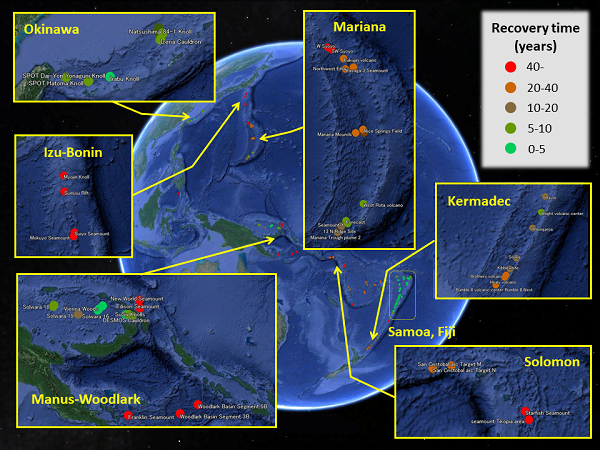
Mapping the resilience of chemosynthetic communities in hydrothermal vent fields around the western Pacific Ocean
Hydrothermal vents support unique ecosystems populated by numerous species with unique adaptations. We aimed to determine the resilience of vent communities by investigating whether they are vulnerable or robust to natural disturbances, such as volcanic activity, and anthropogenic disturbances, such as mineral resource mining. One of the ways to assess their resilience is to measure the time required for a disturbed community to recover its original state. A mathematical model capable of predicting resilience would represent an important contribution to the management of these unique ecosystems. However, compared to most terrestrial and shallow water ecosystems, information regarding hydrothermal vent ecosystems, which are typically found at depths of over 1000 m, is limited. We thus focused on a key factor for resilience, i.e., connectivity of vent communities through larval dispersal. This is because when most of the organisms are removed from a vent field, larval supply from other vent fields will be the prominent source for re-establishment. We used estimated larval dispersal between hydrothermal vent fields in the western Pacific Ocean and implemented it as a dispersal matrix of a population dynamics model. By simulating disturbances to hydrothermal vent fields, we mapped recoverability of communities in 131 hydrothermal vent fields in the western Pacific Ocean. Our analysis showed substantial variation in recovery time which ranged from several years to several hundred years due to variation in regional connectivity between vent fields. We also found that, in certain cases, simultaneous disturbance of a series of vent fields either delayed or completely prevented recovery. Our method not only revealed the distribution of recoverability of chemosynthetic communities in hydrothermal vent fields but also introduced an important starting point regarding a practical tool for conservation strategies.
This research was published on 19th June 2018 (18:00 Japan time) in Scientific Reports.

(https://www.google.com/intl/en/earth/; Map data: Google Earth, Image Landsat/Copernicus, Data SIO, NOAA, U.S. Navy, NGA, GEBCO)
Article:
Suzuki, K.*, Yoshida, K., Watanabe, H. and Yamamoto, H. (2018) Mapping the resilience of chemosynthetic communities in hydrothermal vent fields. Scientific Reports 8: 9364. DOI: 10.1038/s41598-018-27596-7
* corresponding author
www.nature.com/articles/s41598-018-27596-7
Contact:
Katsuhiko Yoshida
National Institute for Environmental Studies
16-2 Onogawa, Tsukuba, Ibaraki 305-8506 Japan
kyoshida (please append ‘@nies.go.jp’ to complete the email address)
Kenta Suzuki
suzuki.kenta (please append ‘@nies.go.jp’ to complete the email address)
- What's New
- What's New 2024
- What's New 2023
- What's New 2022
- What's New 2021
- What's New 2020
- What's New 2019
- What's New 2018
- What's New 2017
- What's New 2016
- What's New 2015
- What's New 2014
- What's New 2013
- What's New 2012
- What's New 2011
- What's New 2010
- What's New 2009
- What's New 2008
- What's New 2007
- What's New 2006
- What's New 2005
- What's New 2004
- What's New 2003
- What's New 2002
- Event Information
- Visit NIES